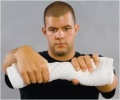Wringing test for lateral epicondylitis: Difference between revisions
Abdul Wajid (talk | contribs) No edit summary |
Abdul Wajid (talk | contribs) (pics) |
||
| Line 1: | Line 1: | ||
<div class="editorbox"><gallery> | <div class="editorbox"><gallery> | ||
Lateral_epicondylitis.jpg | |||
</gallery>'''Original Editor '''-Abdul Wajid | </gallery>'''Original Editor '''-Abdul Wajid | ||
| Line 9: | Line 9: | ||
The Wringing Test is a general screening examination used to detect carpal tunnel syndrome, Lateral epicondylitis or arthropathy.<br> It is a basic test that can help narrow down the focus of a regional examination. | The Wringing Test is a general screening examination used to detect carpal tunnel syndrome, Lateral epicondylitis or arthropathy.<br> It is a basic test that can help narrow down the focus of a regional examination. | ||
== Technique | == Technique == | ||
<gallery> | |||
Patient should be awake and cooperative when performing the wringing test. | wringing test.jpg | ||
</gallery>Patient should be awake and cooperative when performing the wringing test. | |||
# Patient could be seated or standing during the test. | # Patient could be seated or standing during the test. | ||
# Patient wrings a towel or wash cloth. With hands on both ends of the towel, the patient twists it in opposite directions. | # Patient wrings a towel or wash cloth. With hands on both ends of the towel, the patient twists it in opposite directions. | ||
Revision as of 11:47, 11 August 2017
Purpose
[edit | edit source]
The Wringing Test is a general screening examination used to detect carpal tunnel syndrome, Lateral epicondylitis or arthropathy.
It is a basic test that can help narrow down the focus of a regional examination.
Technique[edit | edit source]
Patient should be awake and cooperative when performing the wringing test.
- Patient could be seated or standing during the test.
- Patient wrings a towel or wash cloth. With hands on both ends of the towel, the patient twists it in opposite directions.
- The examiner checks for any numbness, tingling or shooting pain on the wrist or over the elbow area.
Interpretation[edit | edit source]
Positive Wringing Test[edit | edit source]
- Paresthesia or the presence of numbness, tingling sensation or shooting electrical pain. This could indicate carpal tunnel syndrome.
- Elbow Pain could indicate epicondylitis or sprain or strain along the elbow area.
- Wrist Pain could indicate arthropathy or sprain or strain along the wrist area.
Resources[edit | edit source]
add any relevant resources here
Recent Related Research (from Pubmed)[edit | edit source]
Extension:RSS -- Error: Not a valid URL: Feed goes here!!|charset=UTF-8|short|max=10
References[edit | edit source]
References will automatically be added here, see adding references tutorial.







